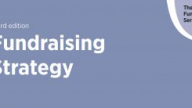The third step in building your fundraising strategy
In the final blog of the mini-series, Richard Sved shares his tactics for delivering a robust fundraising strategy.
“This is how we do it!” Montell Jordan
This is the third of three short blogs based on, at least in a summary version, the much longer book on Fundraising Strategy for DSC which Dr Claire Routley and I co-wrote. In the first blog, I looked at how we can understand where we are now, and in the second I wrote about how we decide on our targets – where do we go from here? – (if you haven’t read these blogs yet, do click on the links above and then return to read this third one). In song title terms, we’ve moved on from David Bowie and Bobby Womack to Montell Jordan: this third blog (and the final one in this mini-series) – This is how we do it! – is about working out how you get there with your fundraising strategy.
Having focused on understanding the field internally and externally for your fundraising, and established your fundraising objectives and audiences, you now need to focus on how you are actually going to do it. So this blog is about the tactics (including scheduling, budgeting and monitoring) that you might use to deliver your strategy.
Firstly, think about the fundraising mix. Your fundraising could include a variety of fundraising methods, such as individual giving (direct response, major giving, legacies), community and events fundraising, grants fundraising, and corporate fundraising – and that is by no means an exhaustive list. How can you ensure that your portfolio is broad and balanced? If the pandemic has taught us anything, it is that circumstances can change, and a variety of fundraising techniques can reduce the risk to your fundraising when it does.
Think about the different areas from a range of perspectives: your strengths and weaknesses in that type of fundraising, the current Return on Investment, how mature it is as a function, for example.
You also might like to consider at this point who the donors are who are at the heart of your strategy, and what you will ask them for. And once they’ve given, what next? How will you thank them? How will you embrace them as supporters and develop a longer-term relationship? What do you need to know about them and their interests and motivations? What do you need to be able to do for them? What will they in turn enable your charity to do? What resources and processes do you need to have in place to manage it all? How can you and your team schedule your fundraising and project manage it?
So that’s a lot of questions that your strategy should be able to answer. And as fundraising projects become larger and involve more people and resources, the planning process is likely to become more complex.
At the same time, of course, you will need to consider your budgeting. This will essentially ensure that you have enough money to deliver the fundraising activities you have planned, and of course that your organisation has enough money to deliver its services. Moreover, you need to plan when the money will be coming in and going out, and project when your fundraising activities will – eventually – make a profit for your organisation. When thinking about expenditure, work through the strategy by task to assess how much each planned activity will cost rather than, for example, relying on previous years’ figures, allocating percentages of donations, or allocating what you think can be afforded.
All good so far? OK, but how will you know whether your fundraising is on track? Do you have a plan for when something doesn’t go as expected? You will arguably need to include the following in your fundraising strategy: performance measurement (so, considering what you want to measure and the metrics you will use to do so), performance diagnosis (thinking about why these results occurred), and identifying risk (and how you will take corrective action).
There’s so much more besides, and a mini blog series will inevitably miss out important key elements, such as getting buy in at all levels, fundraising ethics, avoiding strategic wear out, and especially consideration of equality, equity, diversity and inclusion in your fundraising. You will need to think about all of these things throughout the development and implementation of your fundraising strategy. Ensure that they are never far from the very front of your mind. They are all hugely important – neglect any of them at your peril!
We wish you luck in your fundraising and hope that these blogs as well as the greater detail in the book we’ve written will help you succeed. Get out there and change the world!


